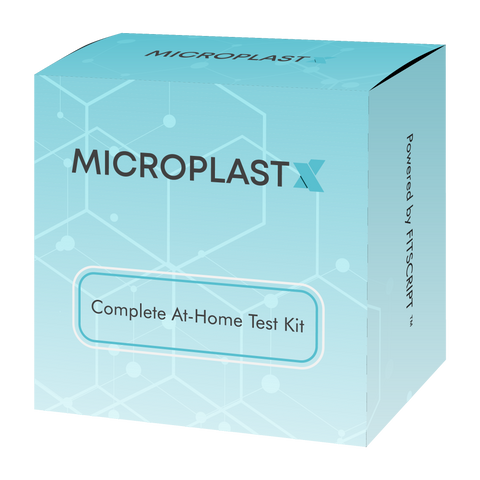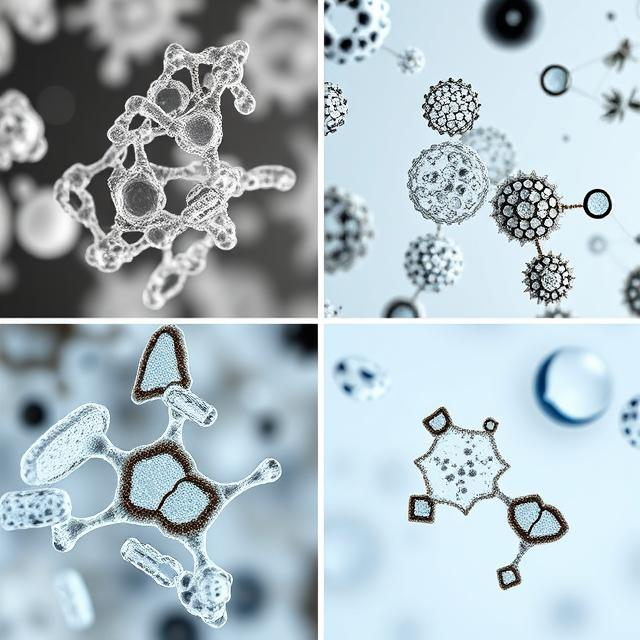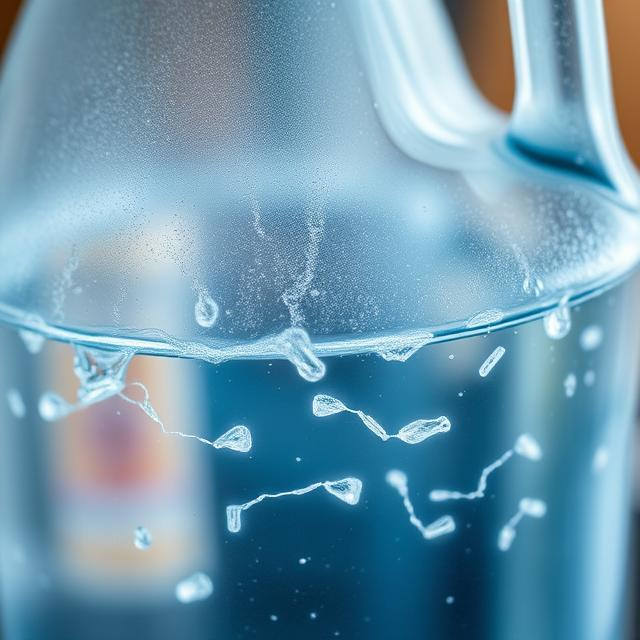Can Nanoplastics in Brain Tissue Impact Your Health? Here’s What Science Say
The journey of nanoplastics into your brain is a subject of intense scientific investigation. Nanoplastics are unimaginably small, measured in nanometers – that's one billionth of a meter. Their minute size is exactly what makes them such a significant concern. When we ingest or inhale plastic particles, whether it's from food packaging, contaminated air, or even our drinking water, these incredibly tiny fragments can potentially cross biological barriers in our body that larger particles simply cannot.
One of the most critical of these barriers is the blood-brain barrier (BBB). This acts like a highly selective gatekeeper, a protective shield that prevents harmful substances circulating in the bloodstream from reaching the delicate and sensitive environment of the brain. However, emerging research, primarily from animal studies, suggests that nanoplastics, due to their miniscule size and certain chemical properties, might be able to breach this crucial barrier. They could potentially slip through cellular junctions or even be actively transported across. Once inside, they could contribute to plastic accumulation in the brain, potentially interacting with neurons, glial cells, and the intricate network that governs our thoughts and actions. This pathway highlights a significant and emerging area of concern for those interested in the impact of widespread environmental contaminants on neurological health and the potential for nanoplastics in brain tissue to become a serious issue. MicroplastX is continually tracking new research on this front to keep you informed about the latest discoveries.
What Conditions Are Linked to Plastic Particles in Brain Tissue?
While research on nanoplastics in brain tissue is still in its early stages and often conducted in laboratory settings or animal models, scientists are actively exploring potential links between plastic accumulation in the brain and various neurological conditions. It’s crucial to remember that this is an emerging field, and more extensive, long-term human studies are needed to draw definitive causal links. However, the theoretical concerns are based on how these foreign particles might interact with delicate brain cells and their complex functions.
Potential areas of investigation and current scientific hypotheses include:
-
Neuroinflammation: The presence of foreign particles, including plastic particles in brain tissue, can trigger chronic inflammatory responses within the brain. This persistent inflammation is a common underlying factor in the progression of many neurodegenerative disorders, such as Alzheimer's and Parkinson's.
-
Oxidative Stress: Nanoplastics might induce oxidative stress, an imbalance between harmful free radicals and protective antioxidants in the body. This imbalance can lead to damage to essential brain cells, proteins, and DNA, potentially contributing to neurodegeneration and cognitive decline.
-
Disruption of Neural Pathways: The physical presence of nanoplastics or the chemicals leaching from them could potentially interfere with the normal signaling and communication between brain cells. This intricate communication is fundamental for all brain functions, ranging from memory formation and learning to mood regulation and motor control.
-
Impaired Neurotransmitter Function: There's concern that these particles, or the chemicals associated with them, could impact the production, release, or reuptake of neurotransmitters – the vital chemical messengers of the brain. Disturbances in neurotransmitter systems are implicated in a wide array of neurological and psychiatric conditions.
-
Aggravation of Existing Conditions: For individuals already predisposed to or suffering from neurological disorders, the additional burden of plastic accumulation in the brain might potentially exacerbate symptoms or accelerate disease progression.
The idea of plastic particles in brain tissue affecting cognitive function, memory, mood, or contributing to neurodegenerative diseases is a serious area of scientific inquiry that MicroplastX is monitoring closely to provide you with the most current understanding.
Are There Studies Showing Nanoplastics in Human Brains?
The scientific community is indeed making significant progress in investigating the presence of plastic accumulation in the brain, and the findings are compelling. While it's a relatively new and complex area of research, studies have begun to reveal concerning findings that strongly suggest nanoplastics can penetrate and reside within human brain tissue.
For instance, recent post-mortem studies on human brain tissue have directly detected the presence of microscopic plastic particles, including those in the nanometer range. These studies, although often preliminary and on a smaller scale, provide concrete evidence that plastic particles can, in fact, make their way into the human brain, successfully bypassing its formidable protective barriers. Specifically, research has identified common plastics like polyethylene, often used in everyday products, within brain samples.
Beyond direct human tissue analysis, extensive animal studies have consistently shown that ingested or inhaled nanoplastics can migrate from the digestive or respiratory systems, successfully cross the blood-brain barrier, and accumulate in the brains of various animal models. These animal studies demonstrate a clear and plausible pathway for exposure and accumulation in humans, reinforcing the concerns raised by human tissue findings. The combination of these preliminary human findings and robust animal research emphasizes the growing reality of nanoplastics in brain tissue and underscores the critical importance of ongoing, larger-scale human investigations.
Understanding this issue is crucial for anyone concerned about their long-term neurological health, and MicroplastX believes in transparently sharing the latest scientific insights. We are committed to furthering this understanding and providing tools to assess personal exposure. Our Microplastics Blood Test Kit can help detect early signs of plastic accumulation in the body, which is a crucial step if you're worried about plastic particles in brain tissue.
What Symptoms Could Signal Plastic Exposure in the Brain?
It's important to be clear: directly linking specific neurological symptoms solely to nanoplastics in brain tissue is challenging right now. This is a new area of science, and the symptoms of plastic accumulation in the brain are not yet well-defined or clinically recognized. However, based on how these tiny particles interact with brain cells in laboratory and animal studies, scientists are exploring potential pathways that could lead to certain issues. If nanoplastics cause inflammation or oxidative stress in the brain, as some research suggests, then this could theoretically contribute to symptoms associated with these processes.
These might include:
-
Cognitive Changes: Subtle shifts in memory, focus, or overall thinking clarity. This is often an early indicator for many neurological concerns.
-
Mood Disturbances: Unexplained shifts in mood, increased irritability, anxiety, or feelings of depression. The brain's delicate chemical balance is crucial for emotional regulation.
-
Fatigue or Brain Fog: Persistent tiredness, difficulty concentrating, or a general feeling of mental sluggishness that isn't easily explained by other factors.
-
Motor Function Issues: In some animal studies, plastic exposure has been linked to changes in movement or coordination, which might be a concern if plastic particles in brain tissue affect motor control centers.
-
Sleep Disturbances: Difficulty falling asleep, staying asleep, or feeling unrested after a full night's sleep.
It's crucial to understand that these symptoms are common to many conditions, and having them does not automatically mean you have plastic accumulation in the brain. However, if you experience persistent or concerning neurological symptoms, especially without a clear cause, discussing them with a healthcare professional is always the right first step. At MicroplastX, we aim to provide information that helps you understand potential environmental factors that might contribute to health concerns, empowering you to have informed conversations with your doctor.
How Can You Reduce Your Risk of Neurological Plastic Exposure?
Given the emerging concerns about nanoplastics in brain tissue and plastic accumulation in the brain, taking proactive steps to reduce your overall exposure to plastics makes good sense. While completely eliminating plastic from your life is nearly impossible in today's world, minimizing your daily contact can significantly lower your risk of absorbing plastic particles that could potentially reach your brain.
Here are some practical steps you can implement:
-
Rethink Your Water: Avoid single-use plastic water bottles. Instead, opt for stainless steel or glass reusable bottles. Consider filtering your tap water using a system designed to remove microplastics. Remember, heat can increase plastic leaching, so avoid leaving plastic water bottles in hot cars.
-
Mind Your Food Storage and Preparation: Use glass, stainless steel, or ceramic containers for food storage instead of plastic. Never microwave food in plastic containers, as heating significantly increases the release of plastic particles. Choose cast iron or stainless steel cookware over non-stick pans that might contain per- and polyfluoroalkyl substances (PFAS), a type of chemical sometimes linked to plastic components.
-
Choose Natural Fabrics: Many clothes, carpets, and furniture are made from synthetic fibers like polyester and nylon, which shed plastic microfibers that can be inhaled. Prioritize natural materials like cotton, wool, linen, and hemp for clothing and home textiles.
-
Filter Your Indoor Air: Air purifiers with HEPA filters can help reduce airborne plastic particles, which are a common source of exposure.
-
Review Personal Care Products: Some cosmetics and personal care items contain microbeads (tiny plastic spheres) or come in plastic packaging that can shed particles. Look for plastic-free alternatives for soaps, shampoos, and skincare.
-
Reduce Processed Foods: Highly processed and packaged foods often have more contact with plastics during manufacturing and packaging. Prioritize fresh, whole foods.
By making these mindful choices, you can significantly lower your exposure to plastic particles that could potentially contribute to plastic accumulation in the brain. MicroplastX is dedicated to providing actionable strategies for a healthier, less plastic-filled life.
Can a Microplastic Test Help You Detect Early Exposure?
With growing concerns about nanoplastics in brain tissue and the pervasive nature of plastic in our environment, many individuals are wondering if they can proactively assess their own exposure levels. The good news is, yes, a microplastic test can help you detect early exposure to plastic particles in your body. While directly testing for nanoplastics in the brain is not a routine procedure, measuring the presence of microplastics and nanoplastics circulating in your bloodstream provides a valuable indicator of your overall systemic exposure.
Consider using a microplastic test if:
-
You're a Regular Consumer of Plastic-Packaged Goods: If your diet or lifestyle heavily involves plastic containers, bottled water, or synthetic clothing, you may have higher exposure.
-
You Have General Environmental Health Concerns: For those who are proactive about understanding their body's burden from environmental pollutants, a microplastic test offers specific insights into plastic accumulation.
-
You Want to Track Your Progress: If you've started making lifestyle changes to reduce plastic exposure, a test can help you see if your efforts are making a difference and reducing plastic particles in your system.
-
You Seek Peace of Mind: Understanding your personal exposure levels can provide clarity and empower you to make more informed decisions about your health and lifestyle.
MicroplastX offers a clear and convenient solution for this. Our Microplastics Blood Test Kit allows you to assess the levels of common microplastics and nanoplastics present in your bloodstream from the comfort of your home. This test can provide an early indication of your body's plastic burden, offering a tangible metric for a concern that is often invisible. Knowledge is power when it comes to managing your health, and understanding your exposure is a powerful first step in addressing the potential impact of plastic accumulation in the brain and overall health.




